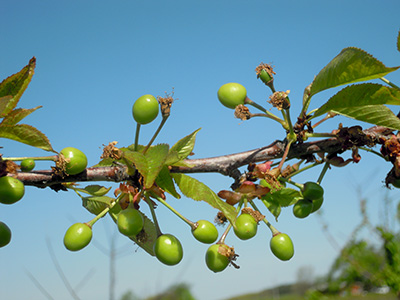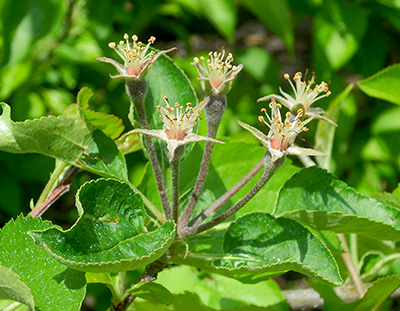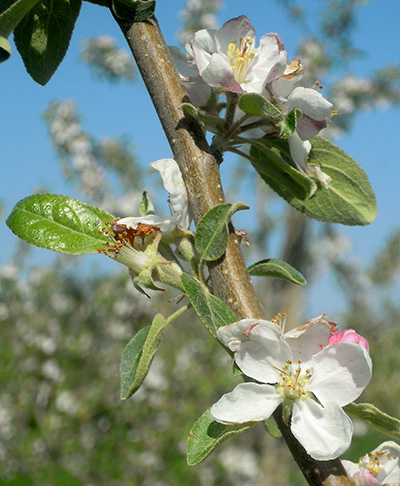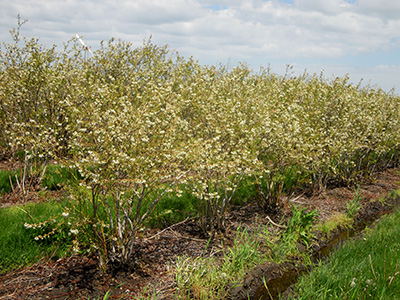Southwest Michigan fruit regional report – May 17, 2016
Weather has been warm and dry, wet and cold and finally windy and cold. Cool weather during bloom has extended bloom in tree fruit and blueberries.

Weather
Last week started warm and dry, during the weekend and Monday, May 9. Tuesday, May 10, was a cool and rainy day. Wednesday was bright, sunny and warm with highs near 70. Storms moved across the region Thursday. Friday began sunny, but was cool, windy and ended with evening rains. Clouds and winds continued through the cold, windy weekend. According to Michigan State University Enviro-weather, Sunday morning saw low temperatures in the low 30s. There was very cold air in place, but the winds prevented significant injury. Similar temperatures across the region (33.5-34.5 degrees Fahrenheit) and in high and low spots indicated that winds mixed the air and prevented an inversion with a cold layer of air at the surface.
There is a good chance of rain on Tuesday, May 17. High temperatures for the week are forecast to start in the 60s and rise into the 70s by Friday through the weekend.
Growing degree-day (GDD) heat accumulations last week were low. We picked up less heat than the previous week and are probably a little behind normal heat accumulation for this date.
Southwest Michigan GDD summary from Jan. 1-May 15, 2016 |
|||
|---|---|---|---|
|
Station |
GDD 42 F |
GDD 45 F |
GDD 50 F |
|
Benton Harbor (SWMRC) |
604 |
468 |
290 |
|
Lawton (Lawton) |
617 |
477 |
293 |
|
Fennville (TNRC) |
481 |
363 |
213 |
|
Average for the region |
555 |
425 |
258 |
|
Accumulation last week |
53 |
46 |
31 |
Tree fruit
Stone fruit range from fully in the shuck to fully out of the shuck. Apple bloom has ended for early blooming varieties but continues for late blooming varieties. Steady rains on Tuesday, May 10, were a significant infection period for apple scab, cherry leaf spot and other diseases. Showers on Thursday, Friday and Saturday last week, May 12-14, were too short and cool for disease infections. Insect activity was low last week because of cool temperatures, but insect activity should increase with warm temperatures later this week.
Oriental fruit moth traps catch numbers were high for a second week. Plum curculio will be a concern with warm temperatures at the end of the week. There are several temperature models used to estimate the beginning of egglaying:
- Average temperature between 55 and 60 F for three or four days.
- Average temperature above 60 F for three days.
- Maximum temperature above 75 F for two days.
Growers should provide insecticide protection for stone fruit that have emerged from the shuck.
Apricots are out of the shuck and fruit are 16 to 20 millimeters in diameter. Exposed fruit should be protected from plum curculio.
Peaches range from in the shuck, through shuck split, to fully out of the shuck. Oriental fruit moth numbers are high in many sites. Biofix, the first sustained flight of oriental fruit moth, was set for Monday, April 25, based on trap catches at the Trevor Nichols Research Center trap line. The Enviro-weather oriental fruit moth model indicates egglaying is underway and egg hatch has begun. Sprays to control the larvae should be applied this week. Rains favor bacterial spot infection of young leaves and fruit. Peach varieties prone to rusty spot should be protected until pit hardening. It is too late to treat peach leaf curl; infected leaves will fall off.
Sweet cherries are generally out of the shuck. The largest fruit are about 12 millimeters in diameter and should be protected from plum curculio. Sweet cherries are susceptible to brown rot at all times so growers need to maintain protection on the fruit during warm, wet periods. Cherry leaf spot infects cherry leaves through the stomates and, once unrolled, the leaves are always susceptible to infection. Tuesday’s rains were a heavy infection period for cherry leaf spot.

Sweet cherry fruit have emerged from the shuck.
Tart cherries are emerging from the shuck. There seem to be at least two distinct sizes. The later bloom is still in the shuck, but the early bloom is out of the shuck. The largest cherries are 6 to 8 millimeters in diameter. An accurate assessment of the crop will need to wait until after the June drop. Fruit should be protected from plum curculio this weekend. Leaves are vulnerable to leaf spot. Growers have been applying protectant fungicides for cherry leaf spot. Tuesday’s rains were a heavy infection period for cherry leaf spot. Last season, cherry leaf spot was a serious problem and some trees were defoliated early. Many of these trees had poor bloom. Some trees showed winter injury with shoot dieback. Some damaged trees are just leafing out.
Japanese plums are emerging from the shuck and fruit set varies from variety to variety and between sites.
European plums are in the shuck. Plums need to be protected against black knot from first bloom until second cover. See “Controlling black knot in Michigan” by MSU Extension for more information. Plum curculio will lay their eggs in exposed fruit when temperatures are in the 70s.
Apple orchards vary a lot in bloom stage. Many are generally past bloom, but late blooming varieties are still blooming. In some blocks there is a heavy bloom on one-year-old shoots. Fruit sizes vary from 4 to 8 millimeters in diameter. Weather conditions later this week will be ideal for apple thinning sprays and growers should assess their crops and prepare to thin when warm weather returns.

Golden Delicious have finished blooming, fruit size is about 4 millimeters.

Jonagold bloom is just getting started.
With the large number of open flowers, growers should to be aware of fire blight. Open bloom is susceptible to fire blight infection with rain during bloom and temperatures above 6 5F. On Monday, April 25, there was a fire blight infection period in parts of Berrien County. According to the Enviro-weather fire blight model, we are only about 70 percent of the way to when symptoms from this infection will be visible. The fire blight bacteria requires temperature above 65 F to multiply quickly and it can take weeks for symptoms to appear under cool conditions.
Apple scab ascospores numbers continue to decline from the peak releases in late April. The Enviro-weather apple scab model indicated that all apple scab spores have matured in some areas, but only 80-90 percent have discharged. Tuesday, April 12, was an apple scab infection. Leaf scab symptoms have been found from April 21 infections. Symptoms from April 30 infections should become visible now and more symptoms will appear later this week. Growers should scout their orchards and look for scab lesions on the leaves, especially this week and next. Coverage to prevent primary scab generally continues into early June.
No codling moths have been caught under these cool conditions. We expect the first catch later this week with warm weather. Spotted tentiform leafminers have been flying for about four weeks. Petal fall is the time to scout for larvae and mines to determine the need to spray for spotted tentiform leafminer. Leafroller larvae are feeding on the shoot tips and leaves in blocks that did not receive pre-bloom insecticide sprays.
Pear bloom has ended. The largest fruit are 8 to 10 millimeters in diameter. There is some rattail bloom. This bloom is susceptible to fire blight infection. Pear psylla adults are flying. The post-bloom period is often used for psylla control. New leaves are tender and can easily absorb systemic materials that kill psylla as they feed. Pears also need to be protected against pear scab and fire blight.
Small fruit
Juice grapes and wine grapes appear to have healthy shoots and wood. Juice grape shoots are 4 to 6 inches with three to five leaves folded back, exposing the flower clusters. Hybrid wine grapes vary, but the most advanced have similar development with leaves unfolding, exposing the flower clusters. Vinifera grapes are at bud burst to 1- to- 3-inch shoots.
As shoot growth begins, shoot tissue is vulnerable to powdery mildew and Phomopsis infection. Fungicides to control these diseases are usually applied as flower clusters become visible. Last week’s wet, rainy conditions were good for Phomopsis infection. Grape berry moth flight has begun, but first generation egglaying is about a month away. Growers and scouts planning to use the Enviro-weather grape berry moth model should note nearby wild grapes in order to record bloom date for use in the model.
Blueberry bloom continues. Many fields away from Lake Michigan were in full bloom by mid-week. Bluecrop is in early petal fall and Jersey is in full bloom. Because of the alternating weather between cool and wet with warm and dry weather, it has been hard to estimate how effective pollination has been. After all the rain, water is standing in many fields. Growers applied sprays to reduce mummy berry infection of the flowers. The flowers are susceptible to infection as they open and susceptibility declines as the flowers age. Sprays are timed for early bloom and mid-bloom. Growers should avoid spraying in the middle of the day when bees are foraging on the bloom. At petal fall, anthracnose becomes a concern and the preferred fungicide changes to include action against anthracnose, mummy berry and Phomopsis.
Cherry fruitworm and cranberry fruitworm trap catches have been zero to one. These moth pests should emerge with warm weather this week.

This field of ‘Jersey’ blueberries is in full bloom.
Strawberry bloom continues. In many fields the primary flowers have been pollinated and are drooping down. Fungicides to control fruit rots and leaf diseases are the primary concern in strawberries. Growers should avoid spraying in the middle of the day when bees are foraging the bloom. Common strawberry leaf spot is the chief concern. If the weather is wetter than predicted, angular leaf spot could be a problem. Growers have put out straw and some have run sprinklers to prevent frost damage to the exposed flower buds.
Bramble growth continues. Primocanes of fall bearing raspberries are growing well. The tallest primocanes are 18 inches tall. In summer bearing raspberries, the flower buds are separating in the clusters. Orange rust is appearing on wild black raspberries. Effective controls can be found in the “2016 Michigan Fruit Management Guide” (E0154).
Upcoming meetings
Our next Monday fruit IPM meeting in southwest Michigan is May 23 at Fruit Acres Farms, located at 2559 Friday Road, on the northeast corner of Friday and Carmody Roads, south of Coloma, at 5 p.m. Two Michigan pesticide applicator recertification credits will be given for these meetings. There is no Monday Fruit IPM meeting on Memorial Day, May 30.
Grape grower’s pre-bloom IPM meeting, with MSU’s Rufus Isaacs and Annemiek Schilder, will be May 25 at 3 p.m. at Cronenwett Farms, 70121 28th St., Lawton, MI. Charge is $10 per person and includes a light meal afterwards. Walk-ins are welcome, but pre-registration is requested so we can order enough food. Two restricted-use pesticide credits will be available. Mail payment and names of attendees to: Jamie Styburski, MSU Extension, 1737 Hillandale Rd., Benton Harbor, MI 49022.
Wine grape mealybug and virus check-in, with MSU’s Rufus Isaacs and Annemiek Schilder, will be June 2 at 3 p.m. at Lemon Creek Winery, 533 E. Lemon Creek Rd., Berrien Springs, MI. We’ll show how to identify mealybug infestation and discuss prevention and treatment. There is no charge for this meeting, but those attending are encouraged to call or email Brad Baughman at 269-927-5674, ext. 4012 or baughm30@anr.msu.edu.
See also
- What are radiation freezes?
- What is the difference between a frost and a freezer?
- Management of bacterial spot on peaches and nectarines
- Chlorothalonil use for pre-shuck split cherry leaf spot control
- Fungicide considerations for cherry leaf spot control at first cover
- Controlling cherry leaf spot in orchards with early infections
- Effectively controlling plum curculio in stone and pome fruits
- Controlling black knot in Michigan
- Apple thinning points for 2014
- How to use Enviro-weather’s apple scab tool
- SDHI fungicides for apple scab management
- Update on resistance to strobilurin fungicides in the apple scab fungus in Michigan
- Plan ahead to manage pear psylla
- Many materials available for pear psylla management
- Protect new grape shoots from early-season fungal diseases
- Mummy berry management in blueberries during bloom
- Invest in pollination for success with highbush blueberries
- Time to prepare for fruitworm management in blueberries.
- Use anthracnose fruit rot prediction model to assess risk of infection.
- Why Intrepid has use restrictions and advice for complying
- Watch out for angular leaf spot in strawberries
- Monitor for orange rust in brambles



 Print
Print Email
Email


